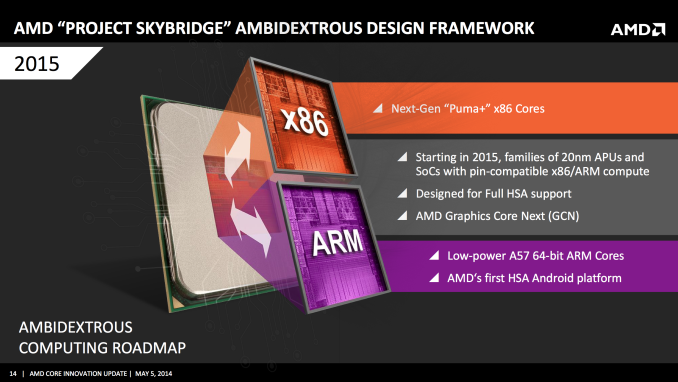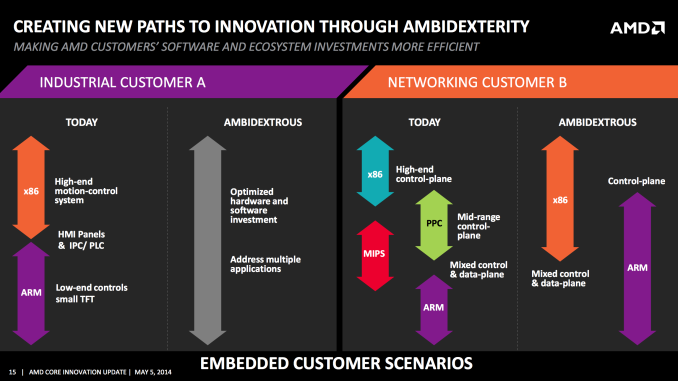AMD Announces Project SkyBridge: Pin-Compatible ARM and x86 SoCs in 2015, Android Support
by Anand Lal Shimpi on May 5, 2014 12:45 PM EST
This morning AMD decided to provide an update on its CPU core/SoC roadmap, particularly as it pertains to the ARM side of the business. AMD already committed to releasing a 28nm 8-core Cortex A57 based Opteron SoC this year. That particular SoC is aimed at the enterprise exclusively and doesn't ship with an on-die GPU.
Next year, AMD will release a low-power 20nm Cortex A57 based SoC with integrated Graphics Core Next GPU. The big news? The 20nm ARM based SoC will be pin compatible with AMD's next-generation low power x86 SoC (using Puma+ cores). The ARM SoC will also be AMD's first official Android platform.
I don't expect we'll see standard socketed desktop boards that are compatible with both ARM and x86 SoCs, but a pin compatible design will have some benefits for embedded, BGA solutions. AMD expects to target embedded and client markets with these designs, not servers.
AMD's motivation behind offering both ARM and x86 designs is pretty simple. The TAM (Total Addressable Market) for x86 is decreasing, while it's increasing for ARM. AMD is no longer married to x86 exclusively and by offering OEMs pin compatible x86/ARM solutions it gets to play in both markets, as well as benefit if one increases at the expense of the other.
Note that we're still talking about mobile phone/tablet class CPU cores here (Cortex A57/Puma+). AMD has yet to talk about what it wants to do at the high end, but I suspect there's a strategy there as well.












34 Comments
View All Comments
rocketbuddha - Tuesday, May 6, 2014 - link
There is no way that AMD would face the "ARM"ageddon of facing their ARM competition with purely ARM designed Cortex cores. It has to have its own custom architecture to differentiate from the numerous Cortex ARM cores that will be in the market from Allwinner to POP all the way up to QCOM.So AMD had to move to custom ARM ISA like QCOM/Apple. Else it cannot afford to compete aginst competition that would have the same technological or in some case better tech nodes than it. It can have Cortex cores as a back-up in case their custom design takes longer to materialize. See how (QCOM is using Cortex A5/A7 & in the future A53/A57 cores).
If you look basically in the x86/x64 world AMD is already developing its own CPU cores based on the x86/x64 ISA. So it has been doing that since the 80s and now it is just adding ARM to the repertoire.
gruffi - Tuesday, May 6, 2014 - link
Or Intel is losing in both markets. They are already losing in the ARM dominated markets. There is actually no dangerous ARM competitor for AMD in the targeted markets yet. Or can you show me a successful company for ARM server chips or ARM clients beyond tablets and smartphones?KenLuskin - Monday, May 5, 2014 - link
In 2015 MSFT will unveil their new OS code named "Threshold".A threshold is the end of something, and the beginning of something else.
Why would MSFT continue to only make Windows for X86 ONLY, when there will be a number of ARM 64 bit chips being released in 2015?
One of the main reasons that PCs are so expensive is because of Intel.
Intel has caused people to believe they need a more expensive chip than necessary to do what 90% of them require.
The other 10% do need a more powerful chip, but most of the additional power is graphics based.
AMD is working closely with MSFT!
Because of the Xbox1 custom APU from AMD, MSFT probably has a closer relationship with AMD than with Intel at this time.
In fact, the main advantage of a PC over Tablet is the substantial increase in GRAPHICS power, and not in the speed of the CPU.
Therefore, I expect MSFT to tweek their next OS to make better usage of AMD's superior graphics, to further DIFFERENTIATE their products from iOS and Android products.
wintermute000 - Monday, May 5, 2014 - link
"In fact, the main advantage of a PC over Tablet is the substantial increase in GRAPHICS power, and not in the speed of the CPU."what?!?!?!?!?!??!??!!??!?!?!??!
MikhailT - Monday, May 5, 2014 - link
Threshold is just a codename for the Windows 9 series of updates for Windows Phone, Windows RT, and Windows OS.It's special because it's going to integrate them all further. We already see the signs of it with the recent universal Windows app stores and universal Windows app binaries. Threshold will go further than that.
Other than that, Windows will live on x86 for a long time due to backward compatibility. It's not going to disappear any time soon.
ARM chips is not at that level where it can emulate x86 quickly enough to not see the difference.
Krysto - Monday, May 12, 2014 - link
I bet Threshold will be another idea from Microsoft that's as stupid as Metro was. Probably something like a subscription-based cloud OS that will alienate 90 percent of their consumer market (I imagine the enterprise market would be fine with it, since they're already kind of paying a "subscription" for Windows/Office support anyway - but it would mean the death of Windows in the consumer market).Penti - Monday, May 5, 2014 - link
So now they (officially) enter spaces they left years ago. They left the mobile gpu business when they sold of the Xilleon and Imageon tech to Broadcom and Qualcomm (Adreno) and they have to compete against Intel, Qualcomm, Broadcom, Imagination, Nvidia and ARM for driver quality, performance and so on now. That will be hard for them. Embedded makes sense, but getting into Android and have to compete against competent gpu-solutions including some of their former technologies of their own with teams that has written drivers for that environment for years will be though. It's quite crowded compared to the PC side with three vendors. Not sure it makes sense to enter GCN into that space with Android.Mathos - Monday, May 5, 2014 - link
Or people could use their brains, and actually read the contents of the article. Realizing they aren't putting ARM and x86-64 on one chip. They're making chips and chipset/mainboard designs that are architecture independent, but fully socket compatible.. Meaning if someone needs a x86 solution they can use an AMD x86 chip. But if they need a low power solution, they can use an AMD ARM based chip on the same base system by simply changing out the CPU. Which would effectively allow fully functional ARM based desktops, with full APU capability, etc.Unfortunately, reading other comments on here I can tell that we have a lot of armchair experts at nothing. Which fail to actually read and comprehend what was written in the article.
People also don't seem to realize that AMD's original chip designs were all RISC based, with x86 decode through firmware.
extide - Tuesday, May 6, 2014 - link
Heh, heh, yeah I don't think people were actually thinking they were making a chip with both ARM and x86 on it (wait they already make one of those*), but they were speculating the possibility.*Cortex A5 security core in Beema/Mullins
Silma - Tuesday, May 6, 2014 - link
AMD hasn't produced a single interesting processor in years.While the ARM road would in fact be an interesting one to explore by Intel, because it also leads the production side of things, I fail to see what added value AMD can bring, since it doesn't own a single fab.